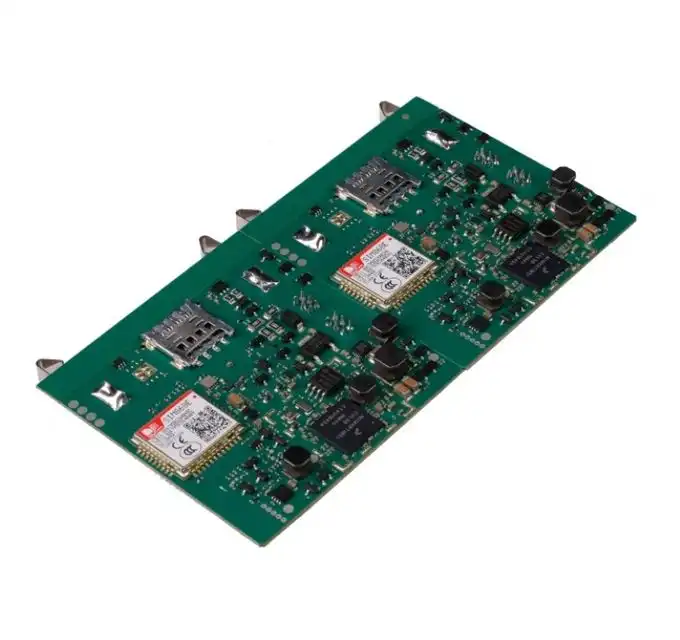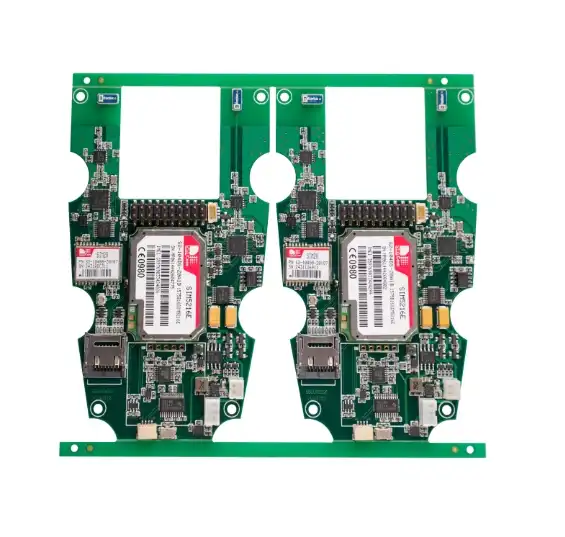The Impact of Material Properties on Multilayer PCB Performance
When it comes to multilayer PCB manufacturing, the properties of the materials used play a pivotal role in determining the overall performance and reliability of the board. High-quality materials are essential for ensuring optimal electrical characteristics, mechanical strength, and thermal stability. These properties are particularly crucial for complex multilayer PCBs that are used in advanced electronic applications.
One of the key considerations in material selection is the dielectric constant (Dk) and dissipation factor (Df) of the substrate. These properties directly affect signal integrity and transmission speeds. Low-loss materials with consistent Dk and Df values across a wide frequency range are preferred for high-speed and high-frequency applications. They help minimize signal distortion and maintain the integrity of data transmission, which is critical in modern electronic devices.
Another important aspect is the thermal performance of the materials. As electronic devices become more powerful and compact, heat management becomes increasingly challenging. Materials with good thermal conductivity and low coefficient of thermal expansion (CTE) are essential for dissipating heat efficiently and preventing thermal stress that could lead to board warpage or component failure. This is particularly important in multilayer PCBs where heat can be trapped between layers.
Advanced Materials for High-Performance Multilayer PCBs
The evolution of multilayer PCB technology has led to the development of advanced materials that cater to specific performance requirements. For instance, high-frequency PCB materials like Rogers 4350B or Taconic RF-35 are designed to maintain consistent electrical properties at high frequencies, making them ideal for RF and microwave applications. These materials exhibit low dielectric loss and excellent dimensional stability, crucial for precision in high-frequency circuit design.
For high-speed digital applications, materials like Megtron 6 or Isola I-Speed offer low Dk and Df values, which are essential for maintaining signal integrity in densely packed multilayer boards. These materials allow for thinner dielectric layers, enabling the design of more compact and efficient multilayer PCBs without compromising on performance.
In power electronics and automotive applications, where thermal management is critical, materials like insulated metal substrates (IMS) or ceramic-filled laminates are often used. These materials offer superior thermal conductivity, allowing for efficient heat dissipation in high-power multilayer PCBs. The ability to manage heat effectively not only improves reliability but also enables higher power densities in compact designs.
Material Selection Considerations for Different PCB Applications
The selection of materials for multilayer PCB manufacturing must be tailored to the specific requirements of the application. Different industries and product types demand varying levels of performance, reliability, and cost-effectiveness. For example, aerospace and defense applications often require materials that can withstand extreme environmental conditions, including high temperatures, humidity, and vibration.
In the automotive industry, multilayer PCBs must be able to operate reliably under harsh conditions, including wide temperature ranges and exposure to chemicals and moisture. Materials with high glass transition temperatures (Tg) and low CTE are often chosen to ensure the stability and longevity of automotive electronics. The use of halogen-free and flame-retardant materials is also becoming increasingly important to meet stringent safety and environmental regulations.
For consumer electronics, where cost and miniaturization are key drivers, materials that allow for high-density interconnects (HDI) and fine-line technology are preferred. These materials must support advanced manufacturing processes such as laser drilling for microvias and sequential lamination techniques. The ability to create thin, high-layer count PCBs with reliable performance is crucial in this sector.
Balancing Cost and Performance in Material Selection
While high-performance materials offer superior electrical and thermal properties, they often come at a higher cost. Balancing performance requirements with budget constraints is a crucial aspect of material selection in multilayer PCB design. In some cases, hybrid designs that use high-performance materials only in critical areas of the board can provide a cost-effective solution without compromising overall performance.
The choice of materials also impacts manufacturing processes and assembly techniques. Some high-performance materials may require specialized handling or processing, which can affect production costs and lead times. It's essential to consider the entire production cycle, including fabrication, assembly, and testing, when selecting materials for multilayer PCBs.
Collaboration between PCB designers, material suppliers, and manufacturers is crucial for optimizing material selection. Advanced simulation tools and material characterization techniques can help predict the performance of different material combinations, allowing designers to make informed decisions before committing to a particular material stack-up.
Future Trends in Multilayer PCB Materials and Manufacturing
The field of multilayer PCB manufacturing is continuously evolving, driven by the demand for higher performance, greater miniaturization, and improved reliability. Emerging trends in material science and manufacturing technologies are shaping the future of multilayer PCB design and production.
One of the key trends is the development of ultra-low-loss materials for 5G and beyond. As communication frequencies continue to increase, materials that can maintain signal integrity at millimeter-wave frequencies are becoming crucial. These advanced materials not only offer superior electrical performance but also need to be compatible with existing manufacturing processes to ensure scalability and cost-effectiveness.
Another significant trend is the integration of embedded components within multilayer PCBs. This approach requires materials that can withstand the embedding process while maintaining their electrical and mechanical properties. The development of new laminate materials and adhesives that can accommodate embedded passive and active components is an active area of research and development.
Sustainability and Environmental Considerations
As environmental concerns become increasingly important, the PCB industry is focusing on developing more sustainable and eco-friendly materials. This includes the use of halogen-free and lead-free materials, as well as exploring bio-based and recyclable substrates. The challenge lies in creating environmentally friendly materials that can still meet the stringent performance requirements of modern electronics.
Advancements in additive manufacturing technologies are also influencing material selection for multilayer PCBs. 3D-printed electronics and hybrid manufacturing processes that combine traditional PCB fabrication with additive techniques are opening up new possibilities for material combinations and board designs. These innovations may lead to more flexible and customizable multilayer PCB solutions in the future.
The increasing demand for flexible and stretchable electronics is driving research into new materials that can maintain electrical performance under bending and stretching conditions. These materials need to combine flexibility with the ability to withstand multiple layers and complex interconnects, presenting unique challenges for multilayer PCB manufacturing.
Conclusion
Material selection is a critical factor in the design and manufacturing of multilayer PCBs. The choice of materials directly impacts performance, reliability, and cost-effectiveness. As technology continues to advance, the demand for high-performance, compact, and reliable multilayer PCBs will only increase. Staying informed about the latest developments in PCB materials and manufacturing techniques is essential for designers and engineers to create innovative and competitive Multilayer PCB Manufacturing products.
For OEMs and companies seeking high-quality multilayer PCB solutions, partnering with experienced PCB manufacturers is crucial. These suppliers and manufacturers can provide valuable insights into material selection, offer advanced manufacturing capabilities, and ensure the delivery of reliable, high-performance multilayer PCBs. By leveraging the expertise of specialized PCB manufacturers, companies can optimize their designs for performance, cost, and manufacturability, gaining a competitive edge in their respective markets.
FAQ
What services does Ring PCB offer for multilayer PCB manufacturing?
Ring PCB offers comprehensive services including PCB fabrication, component sourcing, and full turn-key PCB assembly. We specialize in 5-1000 rapid prototype multilayer PCBs, high-density HDI multilayer PCBs, and provide SMT/through-hole hybrid assembly with AOI/X-ray inspection.
Does Ring PCB handle small batch orders?
Yes, we offer small batch production with no minimum order quantity, ensuring fast delivery and flexible options for our clients.
What quality assurance measures does Ring PCB implement?
We implement strict quality inspection processes including X-ray, AOI, and ICT support. Our triple quality assurance includes AOI, impedance testing, and thermal cycling, with a defect rate of <0.2%, surpassing the industry average.
Vertically Integrated PCB Manufacturing Excellence | Ring PCB
At Ring PCB, we pride ourselves on our vertically integrated manufacturing process, ensuring full control over the entire supply chain. Our self-owned factory manages everything from raw material procurement to production and testing in-house. With global certifications including ISO9001, IATF16949, and RoHS compliance, we deliver high-quality, reliable multilayer PCBs. Our state-of-the-art facility and experienced team are ready to meet your most complex PCB manufacturing needs. Contact us at [email protected] to experience our comprehensive, one-stop PCB and PCBA services.
References
1. Johnson, R. W., & Bauer, J. L. (2019). "Material Selection Strategies for High-Performance Multilayer PCBs." Journal of Electronic Materials, 48(10), 6123-6135.
2. Smith, A., & Brown, B. (2020). "Advancements in Dielectric Materials for Next-Generation Multilayer PCBs." IEEE Transactions on Components, Packaging and Manufacturing Technology, 10(5), 785-797.
3. Chen, X., et al. (2021). "Thermal Management Considerations in Multilayer PCB Design: A Comprehensive Review." International Journal of Heat and Mass Transfer, 168, 120954.
4. Williams, K. L. (2018). "High-Frequency Material Selection for Multilayer PCBs in 5G Applications." Microwave Journal, 61(9), 72-80.
5. Lee, Y. H., & Park, S. J. (2022). "Eco-Friendly Materials and Manufacturing Processes in Multilayer PCB Production: Current Status and Future Prospects." Sustainability, 14(3), 1528.





